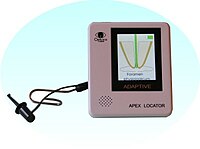History and uses of electronic apex locators
- Original electronic apex locators operated on the direct current principle.
- Conductive fluids in the canal could cause false readings.
- Newer devices are impedance-based, using alternating current of two frequencies.
- Impedance type apex locators are less affected by fluid conductive media.
- Impedance type apex locators are 80 to 95% accurate in identifying the apical foramen.
Adaptive Apex Locators
- Adaptive Apex Locator overcomes the disadvantages of 4th generation apex locators.
- 5th generation locators can experience difficulty in dry canals.
- Adaptive Apex Locator continuously defines humidity of the canal.
- It can measure in dry and wet canals, canals with blood or exudates, and canals with still not-extirpated pulp.
Related information
- Apex location
References
- https://www.oraljournal.com/pdf/2020/vol6issue2/PartH/6-2-56-998.pdf
Categories
- Dental equipment
- Dentistry
- Dentistry stubs
- Medical equipment stubs
An electronic apex locator is an electronic device used in endodontics to determine the position of the apical constriction and thus determine the length of the root canal space. The apex of the root has a specific resistance to electrical current, and this is measured using a pair of electrodes typically hooked into the lip and attached to an endodontic file.


This article needs additional citations for verification. (February 2016) |
The electronic principle is relatively simple and is based on electrical resistance; when a circuit is complete (tissue is contacted by the tip of the file), resistance decreases markedly and current suddenly begins to flow. Various devices signal this event by a beep, a buzz, a flashing light, digital readouts, or a pointer on a dial.